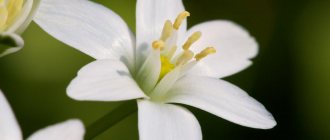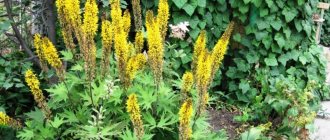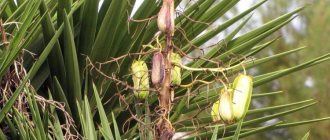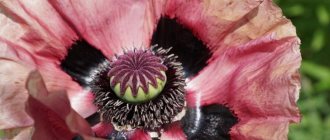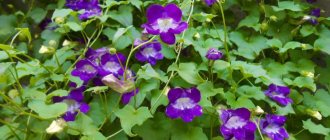A spectacular tropical plant - garden yucca - can decorate your garden plot. It is very exotic and will look spectacular in any garden.
Nowadays, yucca has received well-deserved recognition among amateur gardeners. We will try to consider issues related to its proper fit and subsequent care.
Description and photo of garden yucca
Yucca garden is a perennial shrub. Its foliage is a kind of rosette; inside it the leaves grow in a spiral shape. They are usually green or gray in color and can grow up to 25-100 cm.
In the very center there is a peduncle with white flowers. Over the course of one season, approximately two hundred bell-shaped flowers bloom on the inflorescences, reaching approximately seven centimeters in length and five centimeters in width. After flowering, the seed fruit appears.Types of garden yucca
Two types of yucca are suitable for planting in open ground:
- Gray yucca is a fairly tall plant, not demanding on the soil, and can withstand dry and frosty weather. However, it is extremely sensitive to abundant moisture and watering.
- Yucca filamentosa is a tree-like bush, its sword-shaped leaves reach a length of up to 70 cm and a width of 3 to 10 cm. It is very unpretentious and can withstand air temperatures down to -20C without damage.
Plant characteristics
Yucca can resemble a tree or a bush (depending on the species). The tree-like stem of the plant can be several centimeters or meters high. The leaves of the crop are xiphoid or linear-lanceolate, formed in thick, dense bunches. The main advantage of yucca is its original bell-shaped flowers, reminiscent of panicles; their height sometimes reaches up to 2 meters. After flowering ends, fruits form on the stem - boxes with black seeds.
Varieties of Yucca garden
Botanists have identified more than 50 varieties of Yucca, dividing them all into several varieties:
- Giant yucca (Yucca gigantea). It is considered the most decorative variety. The height of mature palm trees sometimes reaches 9 meters, and the diameter of the crown is about 5 meters. Representatives of this genus are drought resistant.
Giant Yucca (Yucca gigantea) - Yucca filamentosa. The crop has almost no stem, crown diameter is 70 cm. The leaves are green, covered with a bluish coating, and have slight pubescence at the edges. The flowers are usually large in size and have cream or white petals. It presents beautiful buds in mid-June and continues to delight the eye until August. This species is characterized by great resistance to frost.
- Yu. Sizaya (Yucca glauca). It has a short, visually inconspicuous stem, bluish-green leaves, 45-55 cm long. The inflorescences are very tall, bell-shaped, pleasing to the eye until August.
- Yucca Glorious (Yucca gloriosa). A tree-like crop with a miniature or straight trunk. The leaves are green, 65-70 cm in size. Feels good in subtropical conditions.
Yucca filamentosa
Gray and filamentous varieties are grown in gardens; other types are used for planting in containers.
Subtleties of cultivation
To grow yucca in the garden, it is preferable to choose sunny areas, since the plant loves direct ultraviolet rays hitting its leaves. If there are no such places in the garden, you can plant the plant in partial shade, but then it will not be able to form a lush green crown. Yucca is undemanding to the soil, but it is better to plant it in fertile soil mixed with sand or clay.
Yucca glauca
Watering plays an important role in growing crops. Irrigation should be moderate; moisture stagnation should not be allowed, as this will have a detrimental effect on the condition of the leaves. In the evening (after sunset), you can spray the plant using warm water and a small spray bottle.
The plant begins flowering in the 3rd year and continues to delight with beautiful buds for about a month. During this period, it is very important to apply complex fertilizers with the addition of nitrogen. It is recommended to stop feeding a month before the onset of cold weather.
The plant must be covered for the winter, since yucca does not tolerate snowless and frosty winters. First, the leaves are collected at the top, securely wrapped with a strong rope, after which they are covered with a wooden box (can be cardboard), wrapped in fallen leaves or spruce branches. The formed structure is wrapped in agrofibre and secured with tape. Removing the frame is allowed only after the onset of a stable warm temperature.
Yucca gloriosa
Yucca Reproduction
Despite the fact that seeds are formed after flowering, the plant cannot be propagated in this way. For this procedure, daughter rosettes are used, which are formed at the base of the bush. It is better to use cuttings that have their own root system. The daughter rosettes are very simply separated, the cut areas are treated with cinnamon or charcoal, and then planted in the selected area.
Diseases and pests
Planting and caring for yucca is not difficult if you provide it with the proper growing conditions. Otherwise, the plant may be damaged by fungal diseases. If rot is detected on the stem, you need to remove the damaged areas with a sharp knife, and treat the untouched areas with a fungicide.
Among the pests, the most dangerous is the spider mite. To get rid of the insect, use tobacco tincture diluted with water (1:3). The leaves and trunk of the crop are treated with it.
Yucca garden: planting and care
Before planting on the site, the yucca must be hardened off. For this purpose, it should be placed outside for several hours every day. The hardening hours are extended every day, with the result that after fourteen days the plant will be ready for planting.
Yucca is light-loving; illuminated areas on hills are ideal for it.
The use of yucca in the landscape
Spectacular yuccas are good in single and group plantings. Plants look especially impressive on open, flat surfaces (for example, on a lawn). The spreading monumental rosette fits perfectly into compositions with stones and retaining walls made of wild cobblestones.
Yuccas tolerate excess light well, so plants need to be planted in open areas with direct access to sunlight. In the shade the plant develops poorly.
Spectacular massive yuccas harmonize perfectly with garden topiaries; you just need to select light-loving crops for planting with these majestic plants.
Using yucca as a tapeworm is a very good idea; a textured plant always attracts attention and adds a unique flavor to garden design.
Landing Features
Young bushes need small holes, however, further growth should be taken into account. A three-year-old yucca needs a hole with a girth of 70 to 100 cm. The root is buried approximately 40-50 cm.
The best time to prepare the soil for planting is in the fall. Clay-stony, sandy, calcareous soils and black soil are suitable for yucca. They do not tolerate excess moisture well, therefore, it is better to plant them as far as possible from groundwater. The bottom of the hole can be sprinkled with gravel, sand or ash.
After this, the bush is carefully planted, sprinkling the roots with soil. It is better to work with gloves to avoid cuts on your hands. Water not too much, regularly, using water at room temperature.
Spring is best for planting; the air temperature at the time of planting should not fall below +10C at night.
Watering and subcortex
Yucca does not require special conditions and care. It should be watered regularly, but infrequently, after the top layer of soil has dried. Sometimes you can spray the leaves with water, especially if they dry out.
It is best to carry out this procedure in the evening or early morning.
During growth, the plant needs to be fed twice with minerals. First - in May, at the beginning of the growing season, then - immediately after flowering ends.
Yucca garden diseases
Yucca gets sick quite rarely. Sometimes plants experience yellowing and wilting of leaves. If this happens to the lower leaves of the plant, there is no need to worry - they tend to wither and fall off over time, this is a natural process.
Also, yellowing of the leaves occurs in cases where the plant is exposed to a draft or is frozen.
Clarkia graceful - varieties and types, care and planting, diseases + 78 photos- Irises - description of the species, cultivation, reproduction + 102 photos
- Campsis - planting, care, location rules, watering, types of reproduction (67 photos + video)
Pests and diseases
The yucca plant (photo above) may exhibit some symptoms of its unhealthy state. Below are the main diseases and parasites that often attack the flower:
- If the lower leaves of the yucca have become pale, then most likely the plant does not have enough sunlight. Therefore, the affected leaves must be removed and the flower pot moved to a more illuminated place.
- If the plant looks lethargic and weak, then this is a clear sign of improper watering of the flower. In this case, it is necessary to reduce the frequency of watering, and also constantly ensure that excess water does not remain in the trays of the pots.
- Sometimes you can see tufts of gray moss on the flower. This is botrytis - a dangerous fungus that can lead to the death of the entire plant if no measures are taken. In this case, the affected leaves should be trimmed and the entire plant treated with an appropriate fungicide.
- If a gardener notices red dots on the back of yucca leaves, this is a clear sign that the plant is infested with cochineal, a small insect that can be brown or white in color. You can verify this by taking a magnifying glass or magnifying glass and carefully examining the yucca leaves. To combat cochineal, you should either wipe the plant with cotton wool soaked in formic alcohol, or wash the plant with water and neutral soap. Note that chemical products to combat this parasite of domestic flowers effectively cope with their functions only for cochineal larvae, which are more sensitive to fungicides than the adult.
Transfer
With prolonged growth, the yucca grows and requires replanting, but it must be remembered that frequent replanting is harmful to the plant. Experienced gardeners in such cases recommend:
- Transplantation is carried out either in spring or at the end of summer. You need to remove the plant from the ground carefully, without damaging the roots. The emerging shoots are separated and planted separately.
- The new landing site should not be fundamentally different from the previous one.
- The area for planting yucca should be as light as possible.
- The transplanted plant needs to be fed after fourteen days. Flowering should be expected after a year from the moment of transplantation.
Insulation of garden yucca
A logical question often arises - how to properly insulate a garden yucca for the winter and is it necessary to do it?
Filamentous and glaucous yucca are frost-resistant, being quite painless in the face of a short drop in air temperature. In regions with cold winters, garden yucca needs to be insulated.
There are several methods of insulation:
Collect yucca leaves and tie them with twine. To prevent the ground from freezing, place the lower leaves on the ground. The soil near the bush is covered with dried leaves, and boards are laid on top to prevent it from being blown away by the wind.
After this, the bush is covered with polyethylene, the lower part of the trunk is sprinkled with soil.
- Bacopa - description of the species, cultivation, care, reproduction + 74 photos
- Garden hibiscus - types, description, planting, care and propagation + 69 photos
- Celosia - growing from seeds and seedlings, planting in the ground and care rules + 80 photos
There is another method of insulation - using a large wooden box covered with dense material, roofing felt or polystyrene foam will do. Then the insulating structure is covered with dried leaves, after which it is covered with spruce branches or straw, and a film can be placed on top.
It is recommended to carry out insulation in late autumn, at the end of October-November, and it is worth removing the protection only when any threat of cold weather and frost has passed.
Garden yucca will help create an unusual exotic corner on your site. This beautiful tropical plant is extremely unpretentious. With proper care, yucca will delight you for a very long time.
Reproduction
There are three ways to propagate yucca:
TOP 10 best flowers as a gift on March 8What flowers in a pot can be given as a gift on February 14
How to grow and care for Episcia at home (50 photos)
Seeds. They are planted immediately after the fruits ripen in a mixture of sand, leaf soil and turf in equal parts. The top of the container is covered with glass.
If you regularly moisten and ventilate, shoots will appear in about a month. When the sprouts get a little stronger, they are transplanted into small pots and gradually transferred to the care regime as for adult plants.
The barrel. Yucca grows large indoors. Therefore, the upper parts of the trunk can be trimmed and rooted. The process is best done in the summer. The sawn pieces must be more than 20 cm high.
The sections are placed in a container with a mixture of sand and peat and placed in a shaded place in the air. After planting, the cuttings are covered to prevent the substrate from drying out.
After 1-2 months, the yucca will give roots. A cut on an adult plant is treated with garden varnish.
By cuttings. With this method, the tops are cut off. The cuttings are kept in the air for several hours, then placed in a container with boiled water or planted in sand.
When growing in a jar, a piece of charcoal is thrown into the bottom. If any leaves come into contact with water, they may begin to rot. They need to be removed and fresh water added. After the roots appear, the cuttings are planted in the ground.


